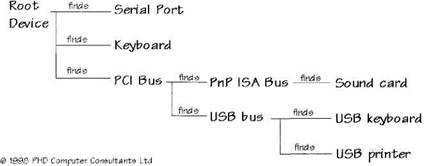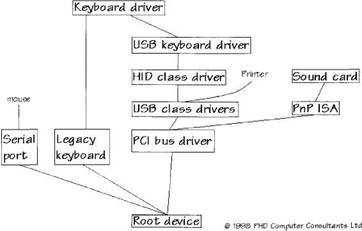Книга: Writing Windows WDM Device Drivers
Device Enumeration
Разделы на этой странице:
Device Enumeration
The enumeration process finds all the devices on a user's PC.
Fixed and Configurable Devices
As you probably know, most of the hardware devices on a PC motherboard are found at fixed locations. For example, on most PCs, the keyboard controller is something that looks like an 8042 processor that can be accessed at I/O ports 0x60 and 0x64. The keyboard controller interrupts on line IRQ1.
This approach works satisfactorily for the one keyboard controller that every mother-board has. However, with serial ports and the old ISA bus, things soon started to get too complicated for most users. If an old ISA bus card just uses fixed addresses and interrupts, it could easily conflict with another card. An interim solution was to provide jumpers and switches on each card to make it configurable. However, configuring this hardware was too much for most mortals to cope with.
The solution to this problem is to have devices that are configurable by software. This means that a bus driver tells each card or device where it should be located, possibly according to assignments given by the PnP Manager. All the newer buses, such as PCI, USB, and IEEE 1394 are software-configurable. Some PnP ISA devices are configurable in software, as well.
Usually, this works as follows. When a card or device powers up, it is detected by its bus driver. The bus driver uses the slot or port number to interrogate the device. Some configuration information or a device descriptor tells the bus driver what sort of resources the card needs. The bus driver or the PnP Manager then allocates the resources appropriately and tells the card this information, either by sending it a command or by writing to its registers. The card then configures itself to respond at the addresses it has been given. The card or device can then start operating normally.
The PnP Configuration Manager sorts out the basic system resources for drivers: I/O ports, Memory addresses, DMA channels, and Interrupts. However, the bus resources required in a particular bus environment are usually controlled by the bus driver. For example, only the USB drivers know about bandwidth allocation on the USB bus. When a USB client driver tries to configure its device, the USB bus driver decides if its bandwidth requirements can be satisfied.
Some types of device can be reconfigured after they have powered up. Configurable hot-pluggable devices can be plugged in or unplugged while the computer is switched on. The appropriate bus driver detects these changes and allocates or deallocates the card or device's resources. However, subsidiary buses are usually designed so that resources do not need to be reassigned in mid-flow.
Enumeration
When Windows is started, it does not know which devices are attached to the computer. It can work out some basic information for itself, such as how much memory it has, but how does it find out about the rest?
Windows uses drivers to enumerate the available hardware. Enumeration means finding and listing any available devices. Arbitrators are then used to juggle all their resource requirements. An appropriate driver (or drivers) is found for each device. The drivers are then told which resources to use, and off they go.
Figure 8.4 shows how enumeration works. Enumeration starts at the lowest level. The root device in the PC finds the basic chips that are on the motherboard[19]. It finds any simple devices, such as built-in serial ports and the keyboard. It also finds the PCI adapter, the electronics that control the PCI bus.
The PCI bus driver then enumerates and configures any hardware it finds. First, it finds a bridge to the ISA bus. The driver for this then finds a PnP ISA sound card, and the sound card drivers are loaded.
The PCI bus driver also finds a USB bus controller. The USB drivers enumerate the USB bus and find a keyboard and printer attached. These are configured and the appropriate drivers are loaded.
Figure 8.4 Hardware enumeration

Device Tree
Figure 8.5 shows a device tree for part of my PC. A device tree is usually shown growing upwards from a root device at the bottom. The lower-level drivers are the ones that interact with the hardware.
As can be seen, the main keyboard driver can get information from two sources, either the legacy keyboard or a USB keyboard. The USB keyboard driver is layered above the HID and USB class drivers and the PCI bus driver. Whether the keyboard is legacy or USB, Win32 gets the same response: the drivers hide the hardware.
Figure 8.5 Device tree

The advantage of this approach is that each driver builds upon the work undertaken in lower layers, making it much easier to write most drivers. Indeed, it is the only way to write some types of drivers. If you are writing a USB driver, you must access your device through the USB class drivers. This means that you have to learn the specification of the relevant class driver. However, this is a far easier task than writing a huge monolithic driver that works with other similar drivers.
One possible drawback is that all this layering of drivers will take more processing time. While this is certainly a valid criticism, it is likely that a monolithic driver would use similar layering internally, so I/O should not take too much longer. More importantly, drivers that are easier to write are more likely to be stable.
- 8.3.3 Enumeration
- Chapter 8 Plug and Play and Device Stacks
- Creating and Deleting Device Objects
- Introduction to Serial Devices
- Devices
- The Disk as a Storage Device
- Chapter 8. Device Driver Basics
- 18.2.5. Block devices
- 8.1. Device Driver Concepts
- 8.1.2. Device Driver Architecture
- 8.1.3. Minimal Device Driver Example
- 8.1.5. Installing Your Device Driver




